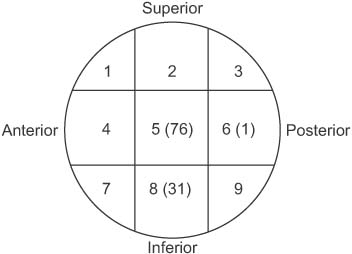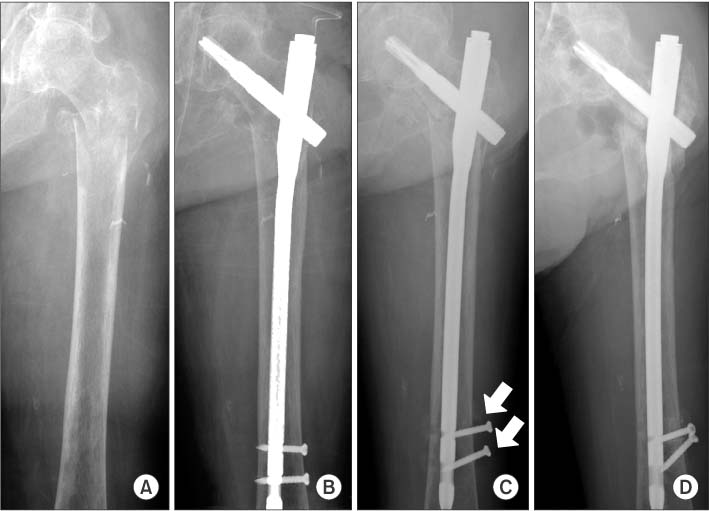J Korean Orthop Assoc.
2015 Aug;50(4):290-298. 10.4055/jkoa.2015.50.4.290.
Results of Patients with Unstable Femoral Intertrochanteric Fractures Treated with Proximal Femoral Nail Antirotation II
- Affiliations
-
- 1Department of Orthopedic Surgery, Pusan National University Yangsan Hospital, Pusan National University School of Medicine, Yangsan, Korea. kuentak@pusan.ac.kr
- KMID: 2035865
- DOI: http://doi.org/10.4055/jkoa.2015.50.4.290
Abstract
- PURPOSE
The purpose of this study was to evaluate radiologic and functional outcomes of patients with unstable femoral intertrochanteric fractures treated with proximal femoral nail antirotation II (PFNA II).
MATERIALS AND METHODS
Between August 2009 and December 2013, 108 hips (108 patients) with unstable femoral intertrochanteric fractures were treated with PFNA II and followed for at least 1 year. The mean follow-up period was 15.2 months. The radiographic outcomes, reduction state, sliding distance of the helical blade, bone union, and complications were assessed. The functional outcomes were assessed according to the Charnley hip pain scoring system, walking ability, and the Activities of Daily Living index.
RESULTS
The postoperative radiograph showed a good or acceptable reduction in all cases. The mean sliding length of the blade was 4.1 mm. The mean duration of radiologic bone union was 4.8 months. There were 2 postoperative complications including nail breakage and nonunion. The mean Charnley hip pain score was 5.1 points. Preoperative walking ability was restored for 74.1% of patients. Preoperative activities of daily life were restored for 60.2% of patients.
CONCLUSION
PFNA II used for treatment of unstable intertrochanteric fracture showed favorable outcomes. However, due to decreasing walking ability and delayed return to the activities of daily living, further studies are needed, focusing on functional recovery and rehabilitation to improve postoperative clinical outcomes.
MeSH Terms
Figure
Reference
-
1. Kim DS, Shon HC, Kim YM, Choi ES, Park KJ, Im SH. Postoperative mortality and the associated factors for senile hip fracture patients. J Korean Orthop Assoc. 2008; 43:488–494.
Article2. Kaufer H, Matthews LS, Sonstegard D. Stable fixation of intertrochanteric fractures. J Bone Joint Surg Am. 1974; 56:899–907.
Article3. Kyle RF, Gustilo RB, Premer RF. Analysis of six hundred and twenty-two intertrochanteric hip fractures. J Bone Joint Surg Am. 1979; 61:216–221.
Article4. Adams CI, Robinson CM, Court-Brown CM, McQueen MM. Prospective randomized controlled trial of an intramedullary nail versus dynamic screw and plate for intertrochanteric fractures of the femur. J Orthop Trauma. 2001; 15:394–400.
Article5. Albareda J, Laderiga A, Palanca D, Paniagua L, Seral F. Complications and technical problems with the gamma nail. Int Orthop. 1996; 20:47–50.
Article6. Butt MS, Krikler SJ, Nafie S, Ali MS. Comparison of dynamic hip screw and gamma nail: a prospective, randomized, controlled trial. Injury. 1995; 26:615–618.
Article7. Simmermacher RK, Bosch AM, Van der Werken C. The AO/ASIF-proximal femoral nail (PFN): a new device for the treatment of unstable proximal femoral fractures. Injury. 1999; 30:327–332.
Article8. Domingo LJ, Cecilia D, Herrera A, Resines C. Trochanteric fractures treated with a proximal femoral nail. Int Orthop. 2001; 25:298–301.
Article9. Boldin C, Seibert FJ, Fankhauser F, Peicha G, Grechenig W, Szyszkowitz R. The proximal femoral nail (PFN): a minimal invasive treatment of unstable proximal femoral fractures: a prospective study of 55 patients with a follow-up of 15 months. Acta Orthop Scand. 2003; 74:53–58.10. Tyagi V, Yang JH, Oh KJ. A computed tomography-based analysis of proximal femoral geometry for lateral impingement with two types of proximal femoral nail anterotation in subtrochanteric fractures. Injury. 2010; 41:857–861.
Article11. Macheras GA, Koutsostathis SD, Galanakos S, Kateros K, Papadakis SA. Does PFNA II avoid lateral cortex impingement for unstable peritrochanteric fractures? Clin Orthop Relat Res. 2012; 470:3067–3076.
Article12. AO Synthes. The manual of PFNA and PFNA II. Paoli, Switzerland: AO Synthes;2011.13. Park YS. Guideline for the prophylaxis of venous thromboembolism in hip surgery patients. J Korean Orthop Assoc. 2011; 46:95–98.
Article14. Fogagnolo F, Kfuri M Jr, Paccola CA. Intramedullary fixation of pertrochanteric hip fractures with the short AO-ASIF proximal femoral nail. Arch Orthop Trauma Surg. 2004; 124:31–37.
Article15. Cleveland M, Bosworth DM, Thompson FR, Wilson HJ Jr, Ishizuka T. A ten-year analysis of intertrochanteric fractures of the femur. J Bone Joint Surg Am. 1959; 41:1399–1408.
Article16. Baumgaertner MR, Curtin SL, Lindskog DM, Keggi JM. The value of the tip-apex distance in predicting failure of fixation of peritrochanteric fractures of the hip. J Bone Joint Surg Am. 1995; 77:1058–1064.
Article17. Charnley J. The long-term results of low-friction arthroplasty of the hip performed as a primary intervention. J Bone Joint Surg Br. 1972; 54:61–76.
Article18. Koval KJ, Skovron ML, Aharonoff GB, Meadows SE, Zuckerman JD. Ambulatory ability after hip fracture. A prospective study in geriatric patients. Clin Orthop Relat Res. 1995; 310:150–159.19. Koval KJ, Zuckerman JD. Functional recovery after fracture of the hip. J Bone Joint Surg Am. 1994; 76:751–758.
Article20. Radford PJ, Needoff M, Webb JK. A prospective randomised comparison of the dynamic hip screw and the gamma locking nail. J Bone Joint Surg Br. 1993; 75:789–793.
Article21. Hardy DC, Descamps PY, Krallis P, et al. Use of an intramedullary hip-screw compared with a compression hip-screw with a plate for intertrochanteric femoral fractures. A prospective, randomized study of one hundred patients. J Bone Joint Surg Am. 1998; 80:618–630.
Article22. Strauss E, Frank J, Lee J, Kummer FJ, Tejwani N. Helical blade versus sliding hip screw for treatment of unstable intertrochanteric hip fractures: a biomechanical evaluation. Injury. 2006; 37:984–989.
Article23. Yoo JH, Park JS, Noh KC, et al. The results of proximal femoral nail antirotation: a comparative study with proximal femoral nail. J Korean Hip Soc. 2008; 20:286–292.
Article24. Lv C, Fang Y, Liu L, et al. The new proximal femoral nail antirotation-Asia: early results. Orthopedics. 2011; 34:351.
Article25. Liu Y, Tao R, Liu F, et al. Mid-term outcomes after intramedullary fixation of peritrochanteric femoral fractures using the new proximal femoral nail antirotation (PFNA). Injury. 2010; 41:810–817.
Article26. Lee KJ, Min BW, Kim SG, Song KS, Bae KC, Cho CH. Results of treating senile osteoporotic peritrochanteric fracture with proximal femoral nail antirotation (PFNA). J Korean Hip Soc. 2009; 21:162–168.
Article27. Jette AM, Harris BA, Cleary PD, Campion EW. Functional recovery after hip fracture. Arch Phys Med Rehabil. 1987; 68:735–740.28. Magaziner J, Simonsick EM, Kashner TM, Hebel JR, Kenzora JE. Predictors of functional recovery one year following hospital discharge for hip fracture: a prospective study. J Gerontol. 1990; 45:M101–M107.
Article29. Zuckerman JD. Hip fracture. N Engl J Med. 1996; 334:1519–1525.
Article
- Full Text Links
- Actions
-
Cited
- CITED
-
- Close
- Share
- Similar articles
-
- Results of the Proximal Femoral Nail-Antirotation (PFNA) in Patients with an Unstable Pertrochanteric Fracture
- Comparative Study of Proximal Femoral Nail Antirotation and Zimmer Natural Nail for the Treatment of Stable Intertrochanteric Fractures
- Radiographic Outcomes of Osteosynthesis Using Proximal Femoral Nail Antirotation (PFNA) System in Intertrochanteric Femoral Fracture: Has PFNA II Solved All the Problems?
- Comparative Study of Intertrochanteric Fracture Treated with the Proximal Femoral Nail Anti-Rotation and the Third Generation of Gamma Nail
- Clinical and Radiological Outcomes of Unstable Intertrochanteric Fractures Treated with Trochanteric Fixation Nail-Advanced and Proximal Femoral Nail Antirotation-II: Correlation between Lateral Sliding of the Helical Blade and Lateral Trochanteric Pain





